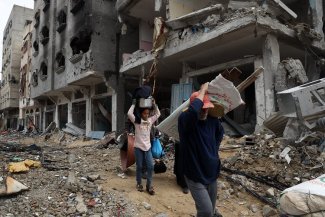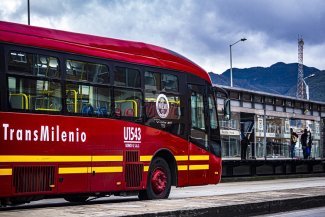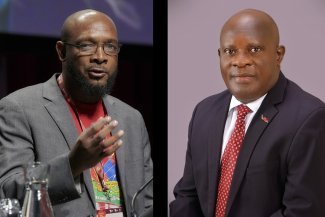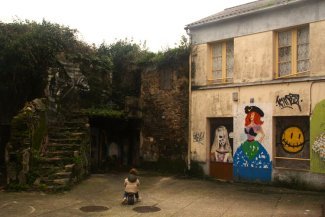E-waste, from discarded electrical and electronic items, is the fastest-growing waste stream in the world. And yet according to the Waste Electrical and Electronic Equipment Forum, only 17.4 per cent of global e-waste was collected and properly recycled in 2019, which means that 44.3 million metric tonnes, valued at US$57 billion, was either placed in landfill, burned or illegally traded and treated in a sub-standard way.
Despite the Basel Convention, which entered into force in 1992 to reduce and prevent the trade of hazardous waste from developed to less developed countries, some of this waste ends up in Ghana, at the scrap section of Accra’s Agbogbloshie Market, where the machines, household goods, car parts and electronic items that cannot be repaired and resold, get dismantled and processed for parts and scrap.
The workers are mostly migrants from northern Ghana, the children of farmers, growers and other land workers who leave their villages in search of better-paid jobs to support their families. Indeed, most migrant workers head to the capital city of Accra with the goal of earning enough money to build a house for their family back home, to pay for studies that will give them a technical qualification (often in mechanics or electrics) or to open a small business.
The migrant workers who arrive at Agbogbloshie with some money in their pocket often start working in the repair and dismantling section. Their relative financial liquidity allows them to buy second-hand items to try and repair for resale, which can earn them up to 80 Ghanaian cedis a day (US$13.75). That which cannot be repaired is dismantled : the parts that can be used for future repairs are kept, everything else is sold by the weight to other workers and then set on fire in allocated burning areas so that valuable metals like copper and aluminium can be extracted for resale.
However, these burning activities are incredibly toxic and completely unregulated, with informal recyclers – some of them children – suffering from burns and the dangerous effects of air, soil and water pollution. Those who end up on the heavily polluted burning sites are those who arrive without money and who are willing to take any job – however dirty or dangerous.
In 2018 and 2019, the London-based Italian photographer Carolina Rapezzi travelled to Ghana to document the workers of Agbogbloshie, producing the photo report Burning Dreams. Here, we publish a selection of the images from her award-winning series.

Sur cette photo du 31 octobre 2018, des travailleurs chargent de la ferraille sur un camion à l’intérieur du parc à ferraille d’Agbogbloshie. Une fois le camion rempli, ils rejoignent généralement le port de Tema, juste à la sortie d’Accra, pour revendre le métal à des revendeurs pour la plupart étrangers.
There are two main components to the scrapyard at Agbogbloshie : in the first, second-hand items big and small, which arrive in containers from Europe and North America in the port in Tema, are offloaded, sorted, dismantled by breakers and traded – often to scrap metal dealers from India and China who are based back in Tema. In the second, the parts that cannot be sold are taken to the dump site where workers light flammable, industrial by-products to burn rubber tyres and the plastic off electrical wires to retrieve the valuable metals for resale.

Alouta (deuxième à gauche) et d’autres travailleurs brûlent des pneus, des pièces de machines, des câbles et des fils dans la zone d’incinération dite « Kilimandjaro » d’Agbogbloshie.
The work at the dump site is informal. Workers stand in the burning areas waiting for a consignment of scrap, and whoever is free to burn gets the job. The biggest fires are usually set at night, to help the workers better manage the heat. Once everything is burnt, the collection of metal scraps usually starts taking place in the very early hours of the morning. However, some metal pickers start working when it is still dark, using the torches on their phones to light up the ground and aid the search for metal scraps.
The practice is highly toxic. As well as leaching lead, mercury and arsenic into the soil, those involved in burning face toxic metal exposure. Lung disease, skin conditions, back problems, headaches, chest pains, burns and infected wounds are common ailments. Long-term health issues include cancer and problems with the respiratory and nervous systems. According to the Global E-Waste Monitor 2020, “Among adults involved in informal e-waste management or living in e-waste communities, DNA damage has been associated with exposure to chemicals in e-waste.”

Le 27 octobre 2018, un groupe d’ouvriers fouille les cendres de fils et de câbles incinérés afin de récupérer des déchets métalliques, qu’ils revendent ensuite à des ferrailleurs.
Workers in the burning area – both metal collectors and burners – tend to be the youngest and newest workers at the dump site. As a result, they are also the ones who earn the least, as they are paid in tips by dismantlers who bring their items to be burnt, avoiding direct and continuous contact with the toxic fumes. Therefore, their daily income is very uncertain, as they depend on the quantity of devices brought to the burning area.
The metal that is recovered from the burning process is sold by weight, earning workers an average of 2 Ghanaian cedis (US$0.34) for a pound of aluminium, 13 GHS for a pound of copper ($US2.25) and 1 GHS (US$0.17) for iron (which is sold by the kilo). On a daily basis, burners earn between 30 to 60 GHS (US$5.15 to US$10.30) daily while workers collecting metal scraps earn between 10 to 40 GHS (US1.70 to US$6.90) a day.

Sur cette photo de novembre 2018, Gafaru (âgé alors de 18 ans), originaire de Savelugu dans le nord du pays, fait une pause après avoir brûlé des fils dans la zone appelée ‘Kilimandjaro’ d’Agbogbloshie.
Gafaru lost his hearing as a child, following a high fever and some medication in a remote hospital in the north of the country. He hasn’t visited a doctor since and has no diagnosis for his condition. After he became deaf he stopped going to school and started working with his father as a butcher. He moved to Agbogbloshie at the beginning of 2018 following some friends from the same village who were already working in the burning area. Although he only communicates by gesticulation and lip-reading, he shares that he hopes to become a mechanic one day.

Rashida, d’âge inconnu, attend de vendre de l’eau aux travailleurs qui incinèrent des appareils et des câbles. Comme beaucoup d’autres jeunes filles de la région, Rashida est vendeuse d’eau à Agbogbloshie. Chaque sachet d’« eau pure » (comme sont appelés les incontournables sachets plastiques de 500 ml d’eau) coûte 1 cedi.
Like many other young girls living in the area, Rashida is a water seller in Agbogbloshie. Each bag of ‘pure water’ (as the ubiquitous 500 ml plastic sachets of water are called) costs 1 Ghanaian cedi (the equivalent of US$0.17).
Agbogbloshie is more than just a scrapyard. The main site of Agbogbloshie Market, just opposite the dump site, is one of the biggest and most important food markets in Ghana. In stalls all around the market, women and young girls sell vegetables. The younger ones hawk water and drinks around the scrapyard during the burning sessions, for the water not only quenches the thirst of workers but also extinguishes the fires and cools down the extracted metal.

Sur cette photo du 24 octobre 2018, Mohammed, d’âge inconnu, montre la blessure profonde qu’il a subie alors qu’il brûlait des fils et des câbles quelques jours auparavant. Il n’est pas allé voir un médecin parce qu’il ne pouvait pas se permettre de manquer un jour de travail. Sa blessure n’a donc pas guéri. « Qui va aller travailler pour moi ? » demande-t-il. « J’ai besoin de travailler. J’ai besoin de ce que je gagne pour manger ».
Workers are constantly exposed to hazards at the dump site. They work without protective clothing, without any training and without any health and safety measures. Until last year, seeing a doctor meant losing a day of work and very few people, even in the most urgent cases, could afford to do so. However, in 2019, a first aid centre was opened at Agbogbloshie. Financed by the German development agency GIZ to the cost of €5 million, the health clinic is supplemented by a football pitch and a technical training centre where workshops on safe dismantling and recycling are held as well as training on activities like soap making, baking and hairdressing, all in an attempt to support alternative jobs.
The training centre also houses two machines that can shred bunches of wires and cables to enable workers to extract the metals without burning them. The initiative, set up by the non-profits Pure Earth and Green Advocacy Ghana are said to process up to 30 per cent of the wires and cables that come to Agbogbloshie, but as the machines are not always working and cannot process the full volume of scrap available at the market, for now, the burning continues.

Sur cette photo de novembre 2018, Zakari est photographié à côté de piles d’ordinateurs portables d’occasion à vendre ou à réparer dans le magasin d’ordinateurs de son frère situé dans le quartier Old Fadama d’Accra, juste à côté de la décharge d’Agbogbloshie.
Youssef is originally from the northern city of Tamale. He moved to Accra roughly 17 years ago and for two years he learnt how to repair laptops. With his savings he opened a small shop in the Old Fadama settlement, which is home to approximately 100,000 people. His computer shop was one of the first in the area, and Youssef was joined by his younger brother Zakari in 2005. Together they buy end-of-life computers and laptops from across the city, before dismantling them and selling the spare parts. What cannot be re-used is dismantled, sold by weight to other workers and then burnt to extract the valuable metals.
But e-waste is only one aspect of Ghana’s thriving second-hand computer market. Of the containers of second-hand electronic goods that arrive from Europe and North America in the port of Tema just outside of Accra every day, most are destined for resale. However, there is little official data outside of a 2011 report which claims that around 15 per cent of second-hand electronics were “unsellable” and a significant portion of that would be destined for informal recycling.

La rivière Odaw, dont les eaux sont fortement polluées, sépare le quartier informel d’Old Fadama du parc à ferraille d’Agbogbloshie.
The Odaw River flows through the Korle Lagoon and into the Atlantic Ocean (via the Gulf of Guinea), after passing through the burning area of Agbogbloshie. With the fast pace of industrialisation in the area, the Odaw has become one of the biggest sewage sites in the city. Solid waste, chemicals, industrial and private untreated waste, parts of electronic waste coming from the Agbogbloshie burning areas and the city as well, have led to a massive increase of pollution in the river. There are long-term rehabilitation programmes underway, but at the moment the water continues to flow into the Gulf of Guinea without any filtering or purification system.











